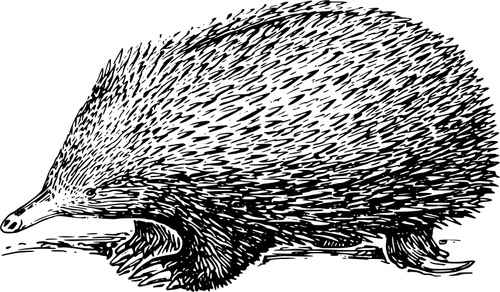The Easter Bunny Should Have Been “The Easter Echidna”
Easter Bunnies being typical mammals don’t lay eggs despite the traditions of German immigrants. In the 1700s German immigrants to Pennsylvania (who also brought us the tradition of “Groundhog Day”) brought over their tradition of an egg-laying hare named “Osterhase” (pronounced “Oschter Haws”). Legend has it, the rabbit would lay colorful eggs as gifts to children who were good, so kids would make nests in which the bunny could leave its eggs. The custom spread across America and became a widespread Easter tradition. Over time, the Easter bunny’s delivery expanded from just eggs to include other candy treats such as chocolate and toys.

Like most mammals, bunny rabbits are viviparous (from latin, vivi = live; and parire “to bring forth” or birth). There are a few egg-laying mammals, but they are in Australia and New Guinea. In fact, only five living species of mammals are not live-bearers: the egg-laying duck-billed platypus and four species of echidna (also known as spiny anteaters). Egg-laying animals are oviparous: (from Latin: ovum = egg, and parire “to bring forth” or “birth”). The unique mammals (e.g., Monotremes and Marsupials) of Australia are due to that continent drifting away from the other continents millions of years ago during mammalian evolution. About 130 million years ago Gondwana began to break up and the continents as we know them today began to drift apart. Australia began to drift northwards at the rate of about 10 cm a year (Australia still moves about 6 to 7 cm per year). And so Australia’s unique fauna evolved.
Birds are egg layers. So they are oviparous. Female birds would be lousy fliers if they carried their clutch of eggs to term! Most lay one egg per day maximum. Also, most adult female birds have only one ovary and one oviduct. Most reptiles are also oviparous (alligators, turtles and others). They lay their eggs in the ground above water or in a nest above water. Female Alligators guard their nests, turtles bury their eggs and depart.
Snakes reproductive patterns are diverse. Seventy percent of snakes are egg layers. Snakes also show viviparity and ovoviviparity. True viviparity is pretty rare among snakes, but it can be found in species such as boa constrictors and green anacondas. The viviparous species nourish their young internally so there is no “shell”.
Most “live-bearing snakes are ovoviviparous (from the latin ovo= egg, vivi = live, and parire “to bring forth” or “birth”). Rattlesnakes, copperheads and other pit vipers are ovoviviparous. Harmless garter snakes are also ovoviviparous. The eggs are retained internally in the female so “hatching” and “birth” are more-or-less simultaneous. They are still called “live-bearers.”

Amphibians are mostly egg-layers. Most female amphibians lay a gelatinous mass of eggs in water, but a few species place the eggs in damp forest floors under vegetation or detritus or even carry them on their backs. Most frog’s and toad’s eggs develop and hatch in the water. There are a few exceptions. The terrestrial, Mexican caecilian and the aquatic cayenne caecilian give birth to fully metamorphosed live young. The embryos are nourished with secretions they scrape off the walls of their mothers’ oviducts. There are a few species of frogs, toads and salamanders that have a similar strategy as the caecilian.
they break out or hatch as tadpoles feeding on detritus and then metamorphose (gain legs and lungs and lose their tail and gills) in preparation for amphibious life. Around the U.S. toads are more terrestrial than frogs, but both pretty much lay eggs in water.
Fish are so diverse and there are so many species they show all three birthing patterns. Most are egg layers. The harsher and the more dangerous their environment then the more eggs they produce. Fish that guard their eggs produce smaller clutches. There are ovoviviparous and viviparous species. Despite their primitive nature, there are shark species that are ovoviviparous and even some viviparous species. The living fossil, the Coelacanth which was thought extinct 70 million years ago turned out to be a live bearer.

Leave a comment